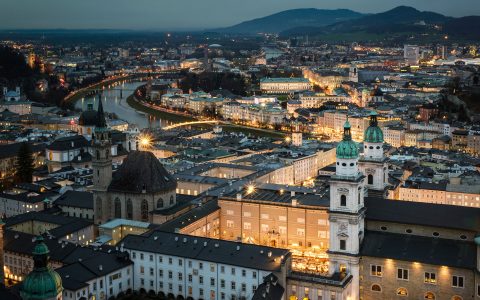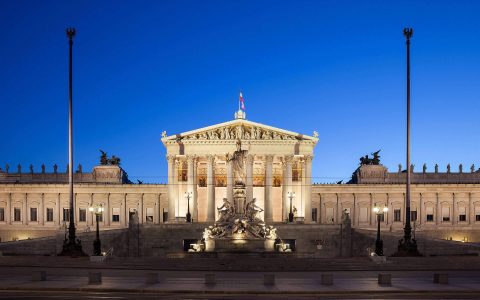Austria’s Wachau Valley: 6 Reasons to Go
 Nestled between the towns of Krems and Melk, Austria’s Wachau Valley is a 30-kilometer (18-mile) stretch alongside the Danube River. Just about an hour’s drive away from the capital city of Vienna, it’s a place worth exploring for its intriguing history and its incredible wines. Here are some of the reasons why it’s one of my favourite places to go.
Nestled between the towns of Krems and Melk, Austria’s Wachau Valley is a 30-kilometer (18-mile) stretch alongside the Danube River. Just about an hour’s drive away from the capital city of Vienna, it’s a place worth exploring for its intriguing history and its incredible wines. Here are some of the reasons why it’s one of my favourite places to go.
A Note on the Wines of the Wachau
 Although wine has been produced in the area ever since the Celts lived here (preceding even the Romans, who arrived in the 1stC BCE). Its real breakthrough on the international wine market happened only in 2014, when a wine from one of the local wineries received 100 ‘Parker Points’ from the famous wine journalist, Robert Parker. Since then, the world has opened up, and now you can find wines from this region in nearly every Michelin-starred restaurant in the world. The Wachau only produces 3 percent of Austria’s total wine production, despite its renown.
Although wine has been produced in the area ever since the Celts lived here (preceding even the Romans, who arrived in the 1stC BCE). Its real breakthrough on the international wine market happened only in 2014, when a wine from one of the local wineries received 100 ‘Parker Points’ from the famous wine journalist, Robert Parker. Since then, the world has opened up, and now you can find wines from this region in nearly every Michelin-starred restaurant in the world. The Wachau only produces 3 percent of Austria’s total wine production, despite its renown.
The most important variety here is the Grüner Veltliner, which found its perfect niche on the 300-year-old, steep, dry stone terraces. Grüner shows its complexity under varied climatic influences. The combination of the heat from the Hungarian plains, the cold coming from the North and the equalizing influence of the Danube is essential to the development of the Grüner Veltliner’s berries; despite attempts to cultivate it in New Zealand and the U.S., this variety has not been successfully grown anywhere else.
The classification in the Wachau follows German practices. Thus, unlike in France for example, where the region is split into higher and lower quality slots, they categorize the wine here based on the natural sugar content of the wine, which manifests itself in the alcohol level. What you want to remember when you select a wine are the three categories of classification. Steinfeder is the lowest category, 11.5% alcohol at most. The middle category is called Federspiel, between 11.5-12.5%, and the top category is Smaragd, with at least 12.5%. In general, these wines are meant to be drunk fresh; very few bottles are kept to age. Even in the top category, you will rarely find anything older than 2-3 years old in regular cellars.

Outdoor activities
As the Danube literally squeezes itself through between cliffs and hills, the natural beauty of this valley is stunning. On top of this, imagine the earlier mentioned dry-stone terraces cut into the slopes, and you’ll find, arguably, the most scenic section of the Danube. Cyclists rule everything here. The best part is, you can ride on both sides of the river. The north bank is more populated, so you’ll pass through more villages on this side; it’s also where most of the vineyards are located. The south bank is more natural and less interrupted with villages. Throughout the Wachau, there are a couple of ferries on which you can cross the river. Apart from cycling, there are great hiking routes crisscrossing the vineyards, going through forests and climbing up to peaks along the river, guaranteeing some of the loveliest views you have ever seen.

See for Yourself
Two must-see European capitals on one magnificent trip—why not? On our Prague to Vienna Biking trip, start in boho-chic Prague and end in elegant Vienna. In between, take in miles of riverside rides past row up on row of vineyards. Glass of Grüner, anyone?
DETAILED ITINERARY
Melk Monastery

The town of Melk is set on the western end of the Wachau valley. This massive Baroque monastery sits right above the water on a cliff as if it was the guardian of the valley. Originally built as a fortification for the Holy Roman Empire, which used present-day Austria as a buffer zone to protect from the looting of barbarian Hungarian tribes. Once the barbarians were “civilized”, these lands gained a fundamentally more important role and the Duchy of Austria began to flourish. The first ruling dynasty, the Babenbergs, gave the fortification to Benedictine monks in 1089 and it soon became a major centre for learning.
The Baroque monastery that you can see today was built in the beginning of the 1700s, managing to survive through the Napoleonic Wars and even the First and Second World wars. In fact, it’s still a living monastery, with monks residing in the closed section of the monastery; they still run a secondary school, with about 900 students in attendance. One of the most impressive parts of the monastery is the ancient library with over a thousand handwritten manuscripts.To this day, the monastery retains one of the most extensive manuscript collections in Europe. An interesting tribute to this library is that the famous Italian author, Umberto Eco in his book The Name of the Rose, named one of his protagonists as Adso of Melk, who serves as the novel’s narrator.

Krems
 Krems, is the other gateway to the Wachau valley. Similar to Melk, it started to flourish only once invading barbarian hordes were stopped and converted to Christians in about the 8thC. From then on, the city was closely associated with wine production and it became the major port for trade on the Danube. In the 11th and 12th century, its population was close to Vienna’s and when the Habsburgs took over from the Babenbergs, they even considered moving their center to Krems. Unfortunately, Swedish troops destroyed most of the city during the 30-years war in the 1600s, there was a resurgence in the 18th century and massive constructions were carried out. Krems got the Unesco World Heritage title as it is considered to be one of the most preserved cities in Europe. Strolling along the Medieval streets, through the old Baroque gates between the two parts of the city, Krems and Stein, is definitely a journey back in time.
Krems, is the other gateway to the Wachau valley. Similar to Melk, it started to flourish only once invading barbarian hordes were stopped and converted to Christians in about the 8thC. From then on, the city was closely associated with wine production and it became the major port for trade on the Danube. In the 11th and 12th century, its population was close to Vienna’s and when the Habsburgs took over from the Babenbergs, they even considered moving their center to Krems. Unfortunately, Swedish troops destroyed most of the city during the 30-years war in the 1600s, there was a resurgence in the 18th century and massive constructions were carried out. Krems got the Unesco World Heritage title as it is considered to be one of the most preserved cities in Europe. Strolling along the Medieval streets, through the old Baroque gates between the two parts of the city, Krems and Stein, is definitely a journey back in time.
The Venus of Willendorf
 The tiny village of Willendorf is located on the north bank, about 10 km (6 mi.) from Melk. It would have probably gone completely unnoticed had archaeologists not found the oldest European piece of art here in 1908. Dating back 25,000 or 28,000 years BCE, it is a 4.4 inch-high fertility statue, which was discovered after workers demolished part of the land where it was found to make space for a railway line. In Willendorf, you can find the highly informative Venusium Museum in town, which tells you the story of the statue and gives you the background. The statue itself, however, is exhibited in Vienna in the Naturhistoriches Museum.
The tiny village of Willendorf is located on the north bank, about 10 km (6 mi.) from Melk. It would have probably gone completely unnoticed had archaeologists not found the oldest European piece of art here in 1908. Dating back 25,000 or 28,000 years BCE, it is a 4.4 inch-high fertility statue, which was discovered after workers demolished part of the land where it was found to make space for a railway line. In Willendorf, you can find the highly informative Venusium Museum in town, which tells you the story of the statue and gives you the background. The statue itself, however, is exhibited in Vienna in the Naturhistoriches Museum.
Castles of the Wachau
 As you cycle along the valley, you see numerous castles (burgs in German) or ruins atop cliffs, in order to control the trade on the river. There is a nicely preserved castle above the town of Spitz, as well as the Burg of Aggstein; however, the most famous of them all is the ruins of Dürnstein.
As you cycle along the valley, you see numerous castles (burgs in German) or ruins atop cliffs, in order to control the trade on the river. There is a nicely preserved castle above the town of Spitz, as well as the Burg of Aggstein; however, the most famous of them all is the ruins of Dürnstein.
Do you remember the legend of Robin Hood, who was fighting his guerilla war in Sherwood Forest against the ‘bad king John’ and waiting for the return of the ‘good king Richard’? That’s a reference to Richard the Lionheart, who was kept as a prisoner at Dürnstein Castle for fourteen months. On his attempt to return home after the Third Crusade, bad weather and unfortunate timing sidelined his safe return; he was recognized in enemy territory controlled by the Babenberg Duke, Leopold of Austria, acting for the German Emperor, Henry VI. The Austrian ruler sent his men to imprison Richard in Dürnstein and did not release him until a colossal ransom was collected by the English people; it took Richard’s mother, Eleanor of Aquitaine, a year to collect 150,000 marks (about double England’s GDP at the time). Apparently, this ransom was worth so much that the entire defense system of Vienna was financed by it!

MORE FROM Europe + Austria

9 Must-Sees Along the Danube River
Austria
Reading for the Road: A Few of Our Favourite Books About Austria
Austria
An Insider’s Guide to Vienna
Austria
Top 5 Driving Routes in Germany, Austria & Switzerland
Austria
An Insider’s Guide to Salzburg
Austria
Vienna’s Christmas Markets
Austria
Notes From the Road: The Unabashed Charm of Bavaria
Austria
8 Reasons Why You MUST Visit Lake Neusiedl
Austria
Butterfield & Robinson’s new cycling tour
Austria
Butterfield & Robinson Danube Biking Cruise
Austria
Butterfield & Robinson Recreates First Ever Cycling Trip To Celebrate 50th Anniversary
Austria








